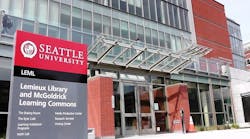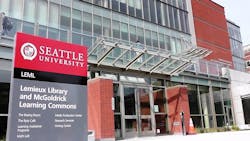SEATTLE — Two unique energy efficient upgrades were made to Seattle University’s Lemieux Library and the McGoldrick Learning Commons — a new addition to the library and LEED certified. Like many established institutions, Seattle University was on a legacy steam system, installed more than 100 years ago.
The University decided to go with a campus-wide hydronic system starting with a unique retrofit to the university’s boiler room. This first phase of the project utilized a primary/secondary pumping arrangement to heat five buildings on campus. New Hydrotherm boilers, capable of producing a total of 14 million BTUs, are equipped with a number of Bell & Gossett Series 60 pumps, while Bell & Gossett VSX split case-style pumps serve the buildings themselves. The new boiler room provides support to five buildings and is connected into another loop that heats an additional five buildings, allowing the pumps to heat a major section of the University.
The Seattle University capital development group had to work with the City of Seattle to get a waiver for the ducting portion of the project so that the University could re-use the old existing ductwork. By adding variable speed drive (VSD) to pumps and fans they were able to realize a greater turn down, thus a greater energy savings. In addition, re-using the existing duct work saved on the installation cost.
One of the major challenges that the university engineers had to overcome was the loop dynamics — very different loops were interconnected that operated in very different ways, and had to work together. In addition, several buildings that used utility steam were added to the hot water loop, which added different complexities and pumping issues. In the end, the finished results saw areas, once getting cold in ambient temperatures, now being fed effective heating, and the buildings using less energy.
“We’ve been very pleased with the results,” said Steve Szablya, P.E., director of facilities, operations and maintenance, Seattle University. “The energy usage has actually gone down, even though we improved the overall square footage of the building.”
The Seattle University boiler project was a true team approach. Columbia Hydronics Company (CHC), the manufacturer’s rep on the project has a sales engineer that works directly with the university. CHC also has a sales engineer that works directly with major mechanical McKinstry Co., Seattle, and their engineering group.
“Between those two calling on the engineers from McKinstry through the design process and our sales engineer that’s calling on Seattle University staff directly, we’re able to supply them with the high efficient boilers as well as the efficiency on the Bell & Gossett pumps,” said Mike Petterson, division sales manager, Columbia Hydronics Company.
Chillin’ at the library
Built in the early 1960s, Seattle University’s Lemieux Library was designed with a dual duct system and no real energy efficient measures in place. “At the time the library had a dual duct system in it, but in the ’60s, people weren’t very energy conscious,” said Calvin Ihler, associate director of facilities operations and maintenance, Seattle University.
In order to achieve a more energy efficient mechanical system, manufacturer’s rep, Columbia Hydronics Company requested smaller, modular chillers to be staged for the library mechanicals. “The condenser water and chilled water systems are served by Bell & Gossett 1510 base-mounted pumps, which go to the twin tower cooling system on the roof, and then take care of the primary chilled water loop. The pumps also serve the secondary chilled water loops that go out to the building,” said Larry Nicholson, P.E., project engineer, McKinstry.
The facility management team wanted to have smaller modular chillers that they could stage on. “Once we went from a low amount of chilling to a higher amount, then we would stage on the Bell & Gossett pumps, and operate them at their peak efficiency,” said Szablya. “They have become the workhorse for the chiller and for chilling on campus.”
“We’ve been overjoyed with this system,” added Szablya. “We were able to take care of one area, where in the winter, it actually would get cold and the tenants knew it would get cold because we just didn’t have the ability to feed it. Now, it’s not only fed but we’re using less energy to get the same thing done.”



